How much of your time as an entrepreneur or member of a young company should be focused on acquiring customers versus developing your product or service?
According to Gabriel Weinberg and Justin Mares, the answer is 50%—split time evenly between building your product or service and bringing in new customers for it.
That’s their argument in Traction: A Startup Guide to Getting Customers, a book based on Weinberg’s experience as the CEO and founder of search engine DuckDuckGo and Mares' time as the director of revenue at error tracking app maker Exceptional Cloud Services. On top of their own stories, they highlight best practices from dozens of successful founders and marketers who are masters at a specific customer acquisition channel, such as email marketing, sales or search engine optimization.
Almost every failed startup has a product. What failed startups don’t have are enough customers.
Traction: A Startup Guide to Getting Customers
Traction lays out a logical progression that any startup can follow to start testing and experimenting with new traction channels and hopefully find new sources of customers. It’s so useful that at Zapier we’re using the Traction framework (which this post will outline soon) to guide our thinking around growth in 2015.
Traction Thinking and Traction Testing
At the core of the methodology in Traction is the notion of "traction thinking" and "traction testing."
Traction thinking means that, as mentioned before, you should be spending 50% of your time on the product and 50% of your time on traction. Anything less and you risk not spending enough effort getting new customers and overbuilding without sufficient user feedback.
But you can’t pursue anything and everything. You have to spend effort only on the traction channels and activities that move the needle for your business, and these will vary by company.
To do this, you need to always be "traction testing." Traction testing is the process by which you identify a possible new opportunity in one channel, spend a small amount of money (or none) seeing if that channel could return good results for your business, and then based on that test either invest more or move on.
"The faster you run high quality experiments, the more likely you’ll find scalable, effective growth tactics," says marketer and entrepreneur Sean Ellis in Traction. "Determining the success of a customer acquisition idea is dependent on an effective tracking and reporting system, so don’t start testing until your tracking/ reporting system has been implemented."
The faster you run high quality experiments, the more likely you’ll find scalable, effective growth tactics.
Sean Ellis, founder of Qualaroo
To know how well these different tests are doing, you need to be dedicated to tracking everything that you can. Only by knowing exactly how well a given channel is performing can you optimize around it. To do so, be sure to not only turn to the free Google Analytics tool, but take advantage of advanced products like Kissmetrics, Mixpanel, or Heap, as well.
Once you’re in the mindset of thinking about traction as much as product, and have the tools in place to see how your tests are performing, you can start applying the Traction methodology to your business.
This post offers descriptions and examples of the 19 customer acquisition channels identified by Weinberg and Mares in Traction and then provides an overview of the authors' "Bullseye Framework", their systematic way to test which channel is best for you. We hope it's helpful to get you started, but to really dig into it, you'll want to pick up your own copy of Traction, which is available via print, ebook or audio.
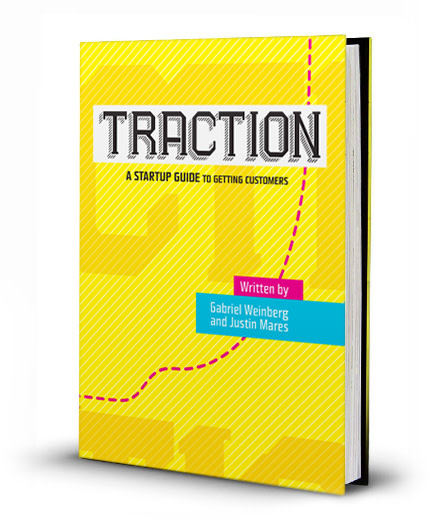
The 19 Traction Channels
As you read through the below traction channels identified by Weinberg and Mares, think about ways you could use them in your business. Don’t quickly dismiss any of them as channels that wouldn’t work for you, the authors warn; take the time to think about creative ways each could be applied. In some cases, the traction channel you think won't work is in reality likely a big opportunity because your competitors are thinking the same thing.
1. Viral Marketing
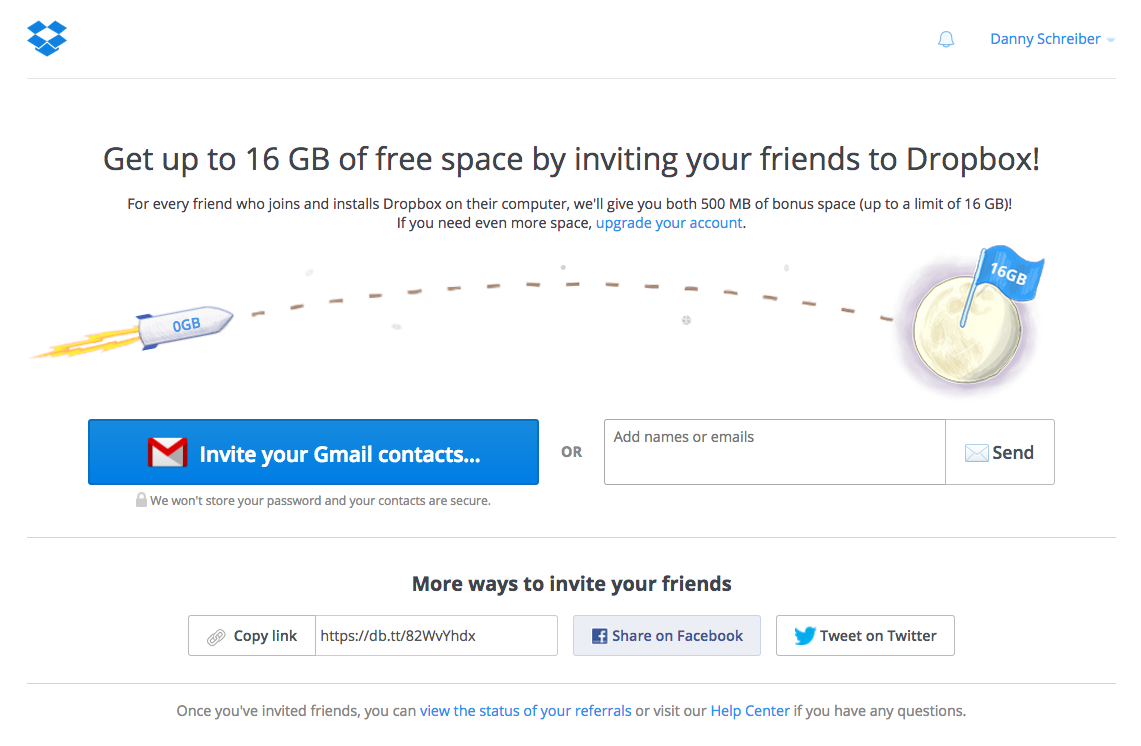
Viral marketing is a process where your users and customers bring you new users and customers, without you having to advertise or market to those new users. There are many ways this can happen:
Word of Mouth - Users and customers simply tell their friends about you
Inherent Virality - User value increases when their friends sign up (e.g. Facebook, Instagram, or WhatAapp)
Collaboration - Products benefit from having other users on them you can work with (e.g. Trello, Podio, or Asana)
Communication - The product is meant for communicating, so you need the people you communicate with to use it (e.g. Slack, Skype, or Telegram)
Incentives - Your users can earn rewards by getting their friends to sign up (e.g. Dropbox, Gilt, or Lyft)
Embedding - Your product can be embedded on other people’s sites, so new users are exposed to it (e.g. Wistia, Typeform, or Disqus)
The ability of a product to go viral is dependent upon the "Viral Loop." The loop is a combination of the speed and effectiveness of your users going through a three-step process:
The user finds or starts using your product
The user tells their friends about it, or invites them to use it
These new users begin using your product, and the process repeats
And your effectiveness in making this loop happen can be judged by your "viral coefficient." The coefficient is a measure of how many other users you can expect one new user to bring. So a viral coefficient of 1 means that each new user will bring on an additional user, and that additional user will bring another additional user, and so on.
To calculate it, you can take your viral mechanism and assess how well it converts for an average user. So, for example, say you give users invitations they can send to their friends. By tracking the number of sent invitations, and dividing that by the number of people who join from invitations, you can measure the viral coefficient for invitations.
Let’s say that in a given week, 200 users send out 1,000 invitations, and that 333 new users join from invitations. Your signup conversion ratio is 1,000/333 or .33, and your rate of referral is 1,000/200, so 5. Multiply the two together (5 x .33) and you get 1.65, your viral coefficient.
To boost this, you can focus either on the conversion percentage (how many sign up from invitations), or on the rate of referral (how many invitations a given user sends out). Weinberg and Mares provide a number of ideas for doing this in the book.
2. Public Relations (PR)
The second channel is to get traction through being talked about in the media. Public relations is the practice of reaching out to magazines, newspapers, blogs, and other media outlets to have them feature a story about your company or product.
When you reach out to a media outlet, you’re doing them a favor. You’re giving them something to talk about, and possibly giving them the first go at a story. Reporters are constantly on deadline so if you can package a story that’s easy for them to tell, they’ll appreciate it.
But how do you get to these publications? One method that’s discussed in Traction is the strategy that marketer Ryan Holiday outlines in his Wall Street Journal bestselling book Trust Me, I’m Lying.
The strategy is called "laddering up." You pitch some small blogs that are related to your niche, who will be most likely to write about you. Then you can take those stories, post them to popular sharing sites like Reddit or Hacker News, and if they perform there then they’ll be likely to be picked up by larger blogs and media outlets who will contact you for more information (or, as Ryan points out, just re-hash the exact same article).
Not sure how to reach out to these blogs? Weinberg and Mares provide some scripts as well as starting points in the book.
3. Unconventional Public Relations

There’s also the flip side of typical public relations: "unconventional" PR. By unconventional they mean anything you could do that would result in a huge amount of publicity without you having to make an effort for it to spread, even if that publicity is negative.
One example of this is the "Will it Blend?" video series run by blender manufacturer Blendtec. These short videos show a "scientist" in a lab coat holding anything from an iPad to a Nike sneaker to a video game peripheral, who then tests to see if it can be blended up in a Blendtec blender thus demonstrating how tough their product is. Spoiler: it usually can.
These videos are relatively inexpensive to make, but they have a large following for their entertainment value. Their YouTube channel has over 750,000 subscribers, and some of their videos, like the one on the initial iPad, have millions of views.
Or how about early last year when Old Spice created fake websites for things such as "Spray Tan Parties," "Fat-to-Muscle Shirts," and "Protein Cologne"? These sites went viral as people pranked their friends sharing them on Facebook, and it resulted in low-cost traffic and sales for Old Spice.
Which raises the question: how can you do something outlandish that fits with your product to draw attention to it? How can you entertain, shock, or amuse while advertising at the same time?
4. Search Engine Marketing
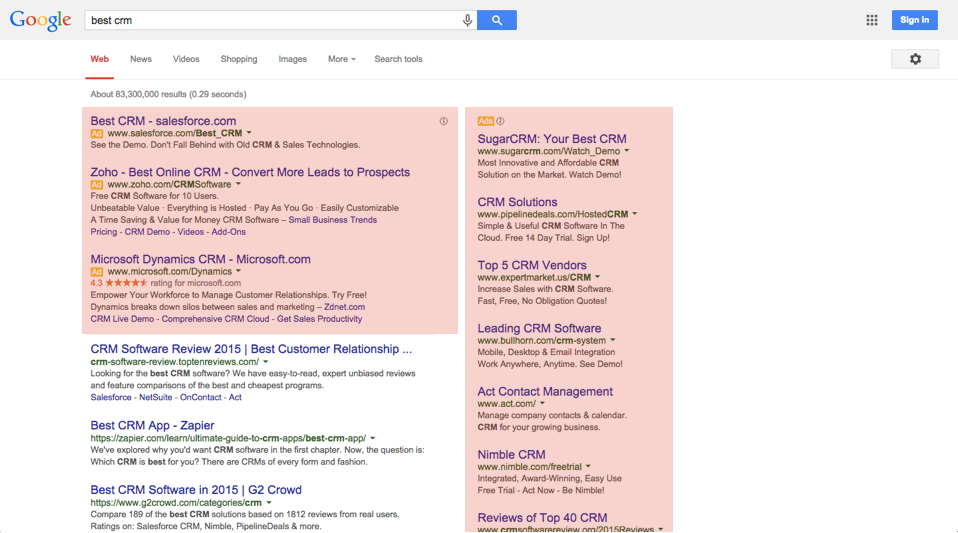
Google’s Adwords is still the largest advertising network online, and if you can afford it, it’s worth testing out. These are the ads that you see above and alongside search results, suggesting certain sites related to the keywords you plugged in that might not be the top ranked sites.
This is especially useful if there are keywords you want to be associated with, but that you don’t have the clout to show up for (yet). By buying ads on search engines, you can show up for those keywords now instead of having to wait until you’ve developed the credibility.
If you’re interested in getting started on Google, you can go to the Google Adwords site and sign up, and look at Bing Ads and Yahoo, as well.
5. Social and Display Ads
Google and the other search engines have competition though. Last year, the total spending on social advertising (such as on sites like Facebook and Twitter) grew 40% to over 8 billion dollars.
The benefit of advertising on social networks is that it will let you target your ads with greater specificity than on Google or another search engine. You can refine your ads by certain demographics, interests, pages people have liked, and more, which you can’t do on a search engine.
Social ads are also a great opportunity for "retargeting," or showing ads to someone based on their activity on your site. Have you ever looked at a piece of clothing only to have it show up on Facebook? That’s retargeting, and Facebook makes it easy to implement it.
If you want to get started on social advertising, check out Facebook and Twitter's advertising hubs.
You can also consider display ads, which are the banner ads that you see on other peoples’ sites. Many of these are done through Google’s Display Network, but there are also other platforms you can look at such as TribalFusion, Conversant, and Adblade.
6. Offline Advertising
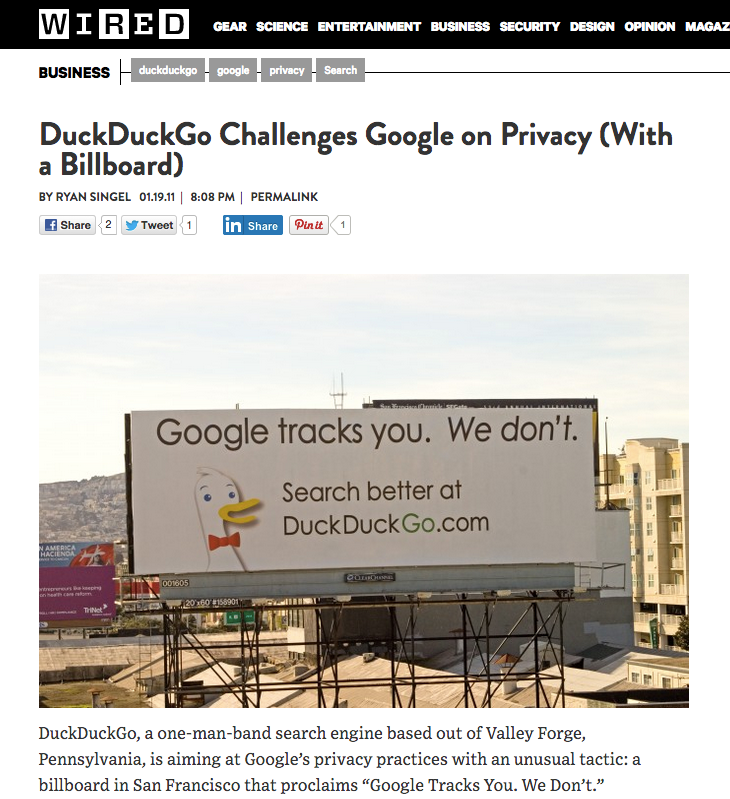
Offline advertising isn’t dead yet, and with how much advertising has moved online, the offline options have gotten cheaper by comparison. The bad part about them is that it’s harder to track exactly how well they’re performing, but the good part is that if you know a few tricks you can get them really cheap.
To take full advantage of this, look into "remnant advertising." This is ad space that is currently not being used or filled, such as ad space in a magazine close to its print date or an empty billboard. Novus Media, as Weinberg and Mares point out, is one example of a company that can help you find this unused ad space.
Tracking is a little different in offline media. Instead of being able to use something like Google Analytics, you’ll want to set up special URLs, coupon codes, or even phone numbers for the advertisements so you know where the traffic is coming from and you're able to measure it. Another simple option is to just ask your users or customers after they sign up how they found you.
7. Search Engine Optimization
Good search engine optimization (SEO) means free traffic for your keywords, which in turn can mean a customer acquisition cost of zero or near zero.
To do this, you need to figure out what types of things your ideal customers would be searching for. If you run a site selling products to help owners of small dogs keep their fur well kept, then maybe your customers are searching for "small dog brushing," "how do I keep my dogs fur soft," or even dog-specific searches such as "Shi-tzu fur maintenance."
Once you have an idea of what terms you want to rank for, you need to create content related to those terms. So in this case you could have separate pages of your site with information about each of these problems, and how someone can best care for their small dog’s fur at home.
To make sure your page ranks for those keywords, you should use the keywords in the URL "slug" (everything after the .com/) as well as in the title or Heading 1 of the page. Also, whenever possible, get other sites to link to those pages as resources on their specified topics, which will tell Google that your pages are good sources of information and that they should rank highly.
For a deeper look at search engine optimization, see "The Beginner's Guide to SEO" from Moz.
8. Content Marketing

Content marketing is the process of creating content that your users and customers would be interested in, distributing it for free or at low price, and then using that content to draw people to your site where they’ll hopefully activate as new users or customers.
There are variety of ways you can publish content, including:
Blog posts related to your field
Informational guides
Videos explaining certain concepts or answering questions
Downloadable ebooks or PDFs
And it doesn’t all have to be on your site. As Weinberg and Mares point out, the fastest way to grow in the beginning is to post your content on other peoples’ sites with links back to yours, so that you leverage their audience to grow your own.
To take advantage of this channel, you should identify what type of content will be most valuable to your target market, create a few pieces that they might be interested in, put them out in the world, and see how they perform. If one type works well, focus on that while you slowly test others, and continue optimizing as you go.
9. Email Marketing
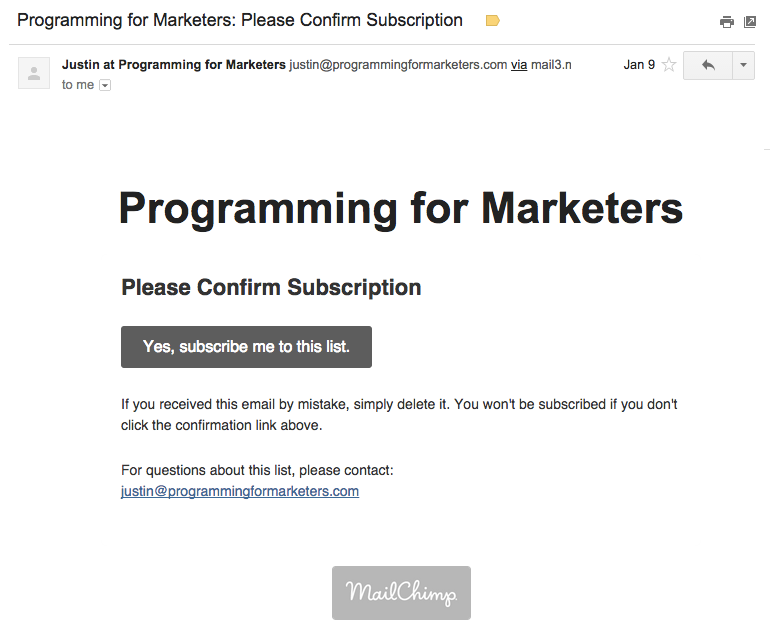
The stats show it: email is the most effective way to re-engage your existing users and customers.
When someone signs up for your site or buys from you, their email address needs to be going into email marketing software like MailChimp or Campaign Monitor. Once they’re there, you can let them know about new features, new products, or send them content that you’ve created that they might be interested in.
That also means that when possible, your blog posts should be converting readers to email list signups. These readers are the people most likely to be interested in learning more about what you have to say, so take advantage of their interest.
Don’t sell too hard in your emails, balance them between useful information and calls to action. In some industries, it’s fine to be more aggressive (e.g. eCommerce) since your customers expect it, but in other industries (e.g. if you sell an expensive paid course) you’ll want to balance value and selling.
10. Engineering as Marketing
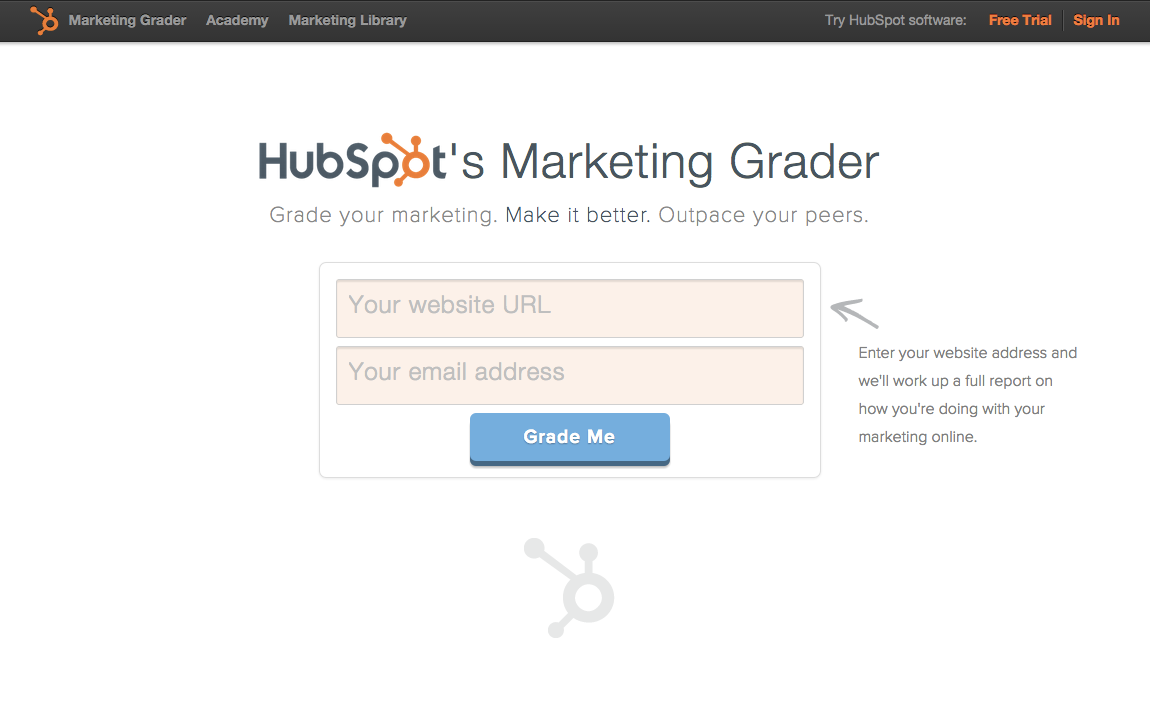
Similar to content marketing, you can use engineering projects that provide value to your target market to draw new users or customers to your site.
This is any web service, app, or free tool that offers value to your target market for little or no cost, while also tying in your product in a way that will be relevant to them either while their using the tool, or immediately after.
Inbound marketing tool HubSpot, Weinberg and Mares point out, created a "Marketing Grader" on a separate URL from their main site where anyone can go to submit their website for review. HubSpot then looks over how you’re doing on your marketing, and suggests ways you could improve it by using their tool. At the same time they have your email address from emailing you the report, so they can follow up with you with other offers you might be interested in.
This is an example of a "micro-site" which you could create with your own tool to promote your product. Other forms of engineering as marketing are embeddable widgets (like Twitter’s embeddable feeds), and annual promotions possibly tying in a micro-site.
11. Targeting Blogs
While it could fall under PR, targeting blogs deserves a special mention, as well. If you can build strong relationships with bloggers in your niche, then they’ll be more likely to reference you and your product in their articles and be more open to letting you share your content to their audience.
To get started, keep a list of all the blogs in your niche that you can find in a spreadsheet organized by size, and by whether or not you have a relationship with them. Reach out to the owners of the blogs with ideas for guest posts that their audience will enjoy, and as you build a reputation in that niche by posting on other peoples’ sites you can move up the chain to more popular sites and blogs.
Make sure you return the favor though. If a blog is letting you post on their site and they’re talking about you, then you should make an effort to share your audience with them as well. This also helps when pitching new blogs--if you can demonstrate that you helped other sites increase their traffic then new sites will be more open to you reaching out to them.
12. Business Development
Business development is the process of establishing partnerships and agreements with other companies or startups to promote each others’ products or services.
You could do a combined sale, share ad space, or find ways to combine your products. You could also establish integrations between your product and another, which is what we do at Zapier.
When a new web service integrates with Zapier (so that their service can be used for automations with other services), they get featured on our blog and we drive traffic to their tool through suggested integrations for our user base. In return, many of our partners feature Zapier in the integrations section of their site to let their users know that they can use us to connect with other services.
It’s a partnership where both parties benefit without having to incur any major costs. When possible, you should look at other companies in your space or a tangential space to see if a similar agreement could be made.
13. Sales
If you have a high cost product, or a piece of enterprise software, then direct sales may be a strong traction channel for you.
Sales is the process of directly reaching out to potential customers or answering incoming inquiries, in order to convince them to buy your product either now or in the future. It’s based on a three-step process:
Generate leads, which you do by looking for people who are decision makers in a company that might be interested in buying your product or service, or giving people the opportunity to opt in to your sales funnel through a free trial on your site.
Qualify leads, which you can do by assessing how much they’re using a trial version of your product, how interested they seem in an initial conversation, and how strong of a fit your offering is for their problem.
Close leads, which is when you finally convince them to make the purchase.
If you pursue this channel, one thing to keep in mind is to always be looking for parts of your funnel that are slowing down the sales process. Are there any inefficiencies, or things that the potential customers could get caught up on that you can smooth out to make the purchasing decision as easy as possible? The fact that you’re calling people directly doesn’t mean that you can’t spend time optimizing your funnel as well.
14. Affiliate Programs
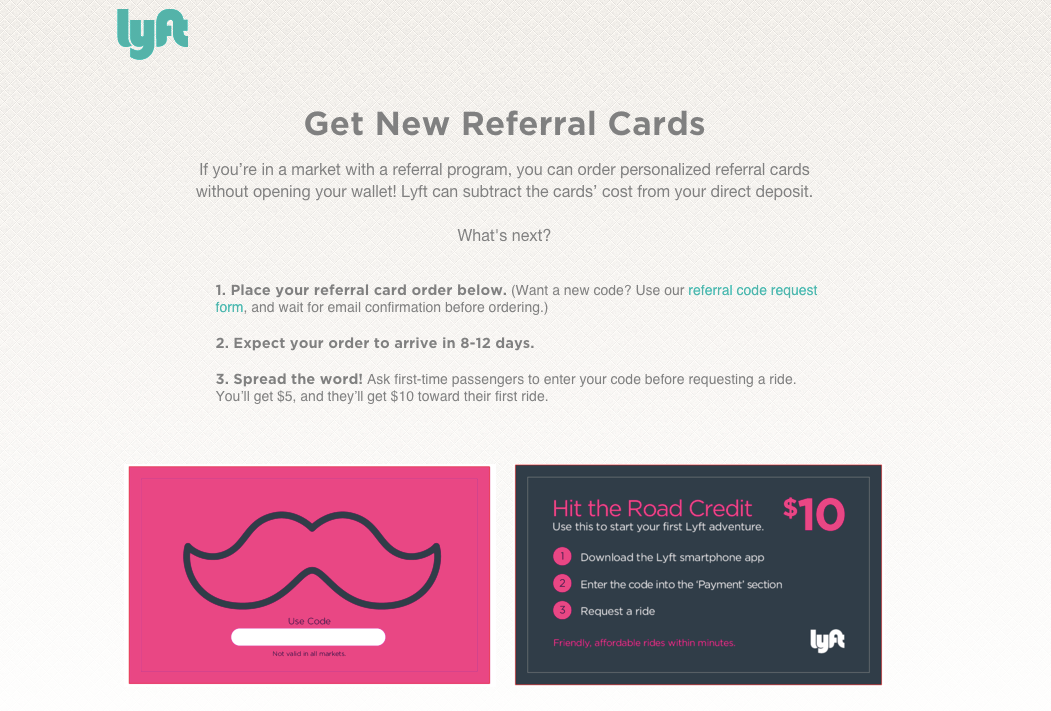
Affiliate programs are a way for you to reward your existing users and evangelists for spreading the word about your product or service. It can be done one of two ways, you can reward them with money or services within your service, or you can reward them simply by paying them for the referral.
Lyft and Uber both utilize the first type of affiliate rewards. They don’t pay you cash for your referrals, but they do give you and whoever you refer credit towards a free ride for getting them to sign up.
The second type, where you make money off of the referrals, is very common in retail. Amazon, for example, offered the first web retail affiliate program and still offers a major one to this day. Users can sign up for an Amazon Affiliate account, and then earn 4-10% on each sale they drive to Amazon’s site.
If you have an expensive product, or one with recurring revenue, you could take part of that revenue as an offer to affiliates for getting people to sign up for the site. This could be a one-time reward for helping sell a specific product, or a recurring reward if they earn you a subscription to a service.
15. Existing Platforms
You can also use existing platforms, especially online, to help promote your product.
This is what Facebook games—yes, all those annoying ones—are doing, but there are less obtrusive ways to take advantage of it. Spotify, for example, would let you share a Spotify update to Facebook depending on what you’re listening to so you could see your friends’ music preferences.
Evernote took advantage of this by being among the first apps on every single mobile operating system, and every new operating system since its inception. It was one of the first apps on iOS, Android, Windows Phone, Windows 8, and it constantly provides updates to all of these systems. By being one of the first apps on the market, it cemented its role as the note-taking app.
If your product or service uses other platforms at all, or could use other platforms, is there a way you can make it stand out there? Or is there a way to own a small niche of an existing platform so that you’re top of the mind for people joining that new app store, site, or community?
16. Trade Shows

The trade show is a classic example of old-school ways to gain early users, but it’s still viable today.
If you’ve never heard of one, a trade show is similar to a college career fair, but instead of booths for companies looking to hire there are booths for companies showing off their products to buyers and other companies.
Trade shows are not only a good way to impress potential wholesale buyers of your product, but they’re an opportunity to impress the media as well. If you can stand out by having a great booth, cool giveaway, or amazing product, the media that’s attending will take notice and likely run a story on you. You can then use that story to "trade up" to larger stories, as we discussed in the public relations section.
17. Offline Events
An alternative to the trade show if you don’t want to wait for the next one, or don’t want to risk being lost in the sea of people, is to host your own event entirely.
The most popular example of this right now is to bring people together through "meetups" on the eponymous site meetups.com. You can host your own group on any topic you want, and in doing so create a community of people who represent some of your target market and could be early test users or early customers. You just have to be careful to balance making sure it’s a valuable event or meetup for everyone, and not just a long sales pitch for you.
Another example is to host a conference related to the field your company works in, where you fly out experts on the subject to give talks about the field and provide advice to people who would also be good customers for you. To make it even more valuable, make sure you record everything and put it online afterwards.
18. Speaking Engagements

In between hosting your own events and going to trade shows, you can also look for opportunities to secure speaking engagements related to your field. If you’re recognized as an expert in what you do, you might get invited to speak at other people’s events or you can pitch yourself as a speaker once you hear about an event being put together.
If you don’t have a reputation, then you can start by speaking at events for free and then putting recordings of the talk online. Over time, your reputation from small events can move you up to local events, and then to regional events, and then to the large national premiere events where you’ll get the most publicity.
Don’t make the speech entirely about your company, but if you’re talking about the field that it works in then mentioning it appropriately is fine. This can be especially useful for enterprise software companies who are looking for a few big sales. Some of your best prospects might be in the room.
19. Community Building
Last but not least there’s community building. Meetups are a type of offline community building, but you can also look at building a web community to attract and keep new users.
Many of the best free sites online operate on community building. Wikipedia, for example, staffs very few people and 99% of the work is done by people passionate about sharing their knowledge from their bedrooms or offices. There’s a community culture of accuracy, verification, and contributing to the project at large.
Yelp is another good example. Reviewers who consistently leave good feedback have their reviews featured more prominently, and are event added to an elite internal Yelp community where they get invited to special dinners and events.
By creating a community like this you can ensure that you have consistently good content for your users, that the product is being built in the ways that will benefit them most, and you can even use it for hiring people who are the most passionate about your product.
The Bullseye Framework: Applying the Traction Method
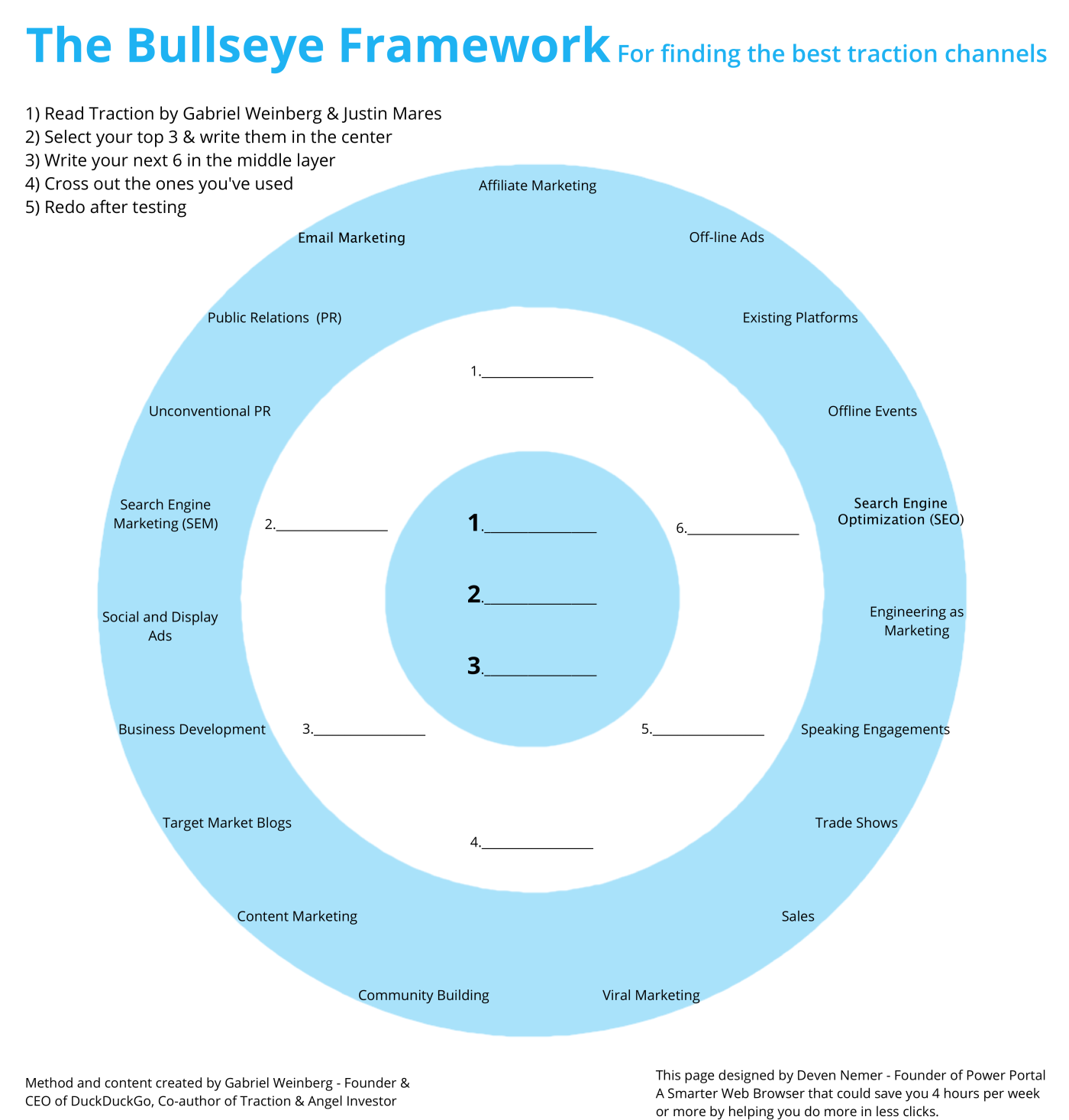
Now that you know the 19 traction channels, use Weinberg and Mares' "Bullseye Framework" to help you decide what you should be going after.
1. Brainstorm
First, you need to go through all of the traction channels and come up with some reasonable ways that you could use it. It’s important to not rule out any traction channel in this step. Even if your first reaction is "oh, that one won’t work for me…" try your best to come up with a way you could make it work.
To guide your thinking around this, list all of the traction channels in a spreadsheet and write down your ideas for how you could use that channel alongside them.
Also on the spreadsheet, you should make sure to list:
On a scale of 1-5, how much potential do you think there is there?
What would be the cost to acquire a new customer or user through this channel?
How many customers could you reach?
And how long would it take you to run a cheap test on that channel?
2. Rank
Once you have ideas and information down for each traction channel, rank them by placing them in one of three categories, or one of three rings in the bullseye. The outermost circle is the "long-shots," the middle circle is the ones with "potential," and the inner circle is your best options.
3. Prioritize
Now look at your inner circle. If you have more than three things there, move some of them out until later. You want to pick the three that you think have the absolute best chance of moving the needle for your business.
4. Test
Once you have your first three chosen, you can start running tests on those channels to see how effective they are. These tests should be as cheap and as fast as possible--do not spend a huge amount of time or money on the first tests.
They should seek to answer questions like:
How much can you expect to spend on customers through this channel?
How many customers do you think you could reach through this channel?
Are the customers you’re getting through this channel the kind you want right now?
If after testing all three none of them seem that viable, go back and test some new ones. But if you do find one that seems promising, then…
5. Focus
Once you’ve demonstrated that a certain channel is viable, then you want to put all of your effort into wringing every last piece of value you can from that channel. Some channels will be better at different stages of the product’s lifecycle. Virality, for example, is hard in the beginning when your user base is small. And Sales might be harder when you’re enormous.
Eventually you’ll plateau in a certain channel, and at that point it’s time to return to the bullseye and try something new.
How We’re Employing "Traction" at Zapier
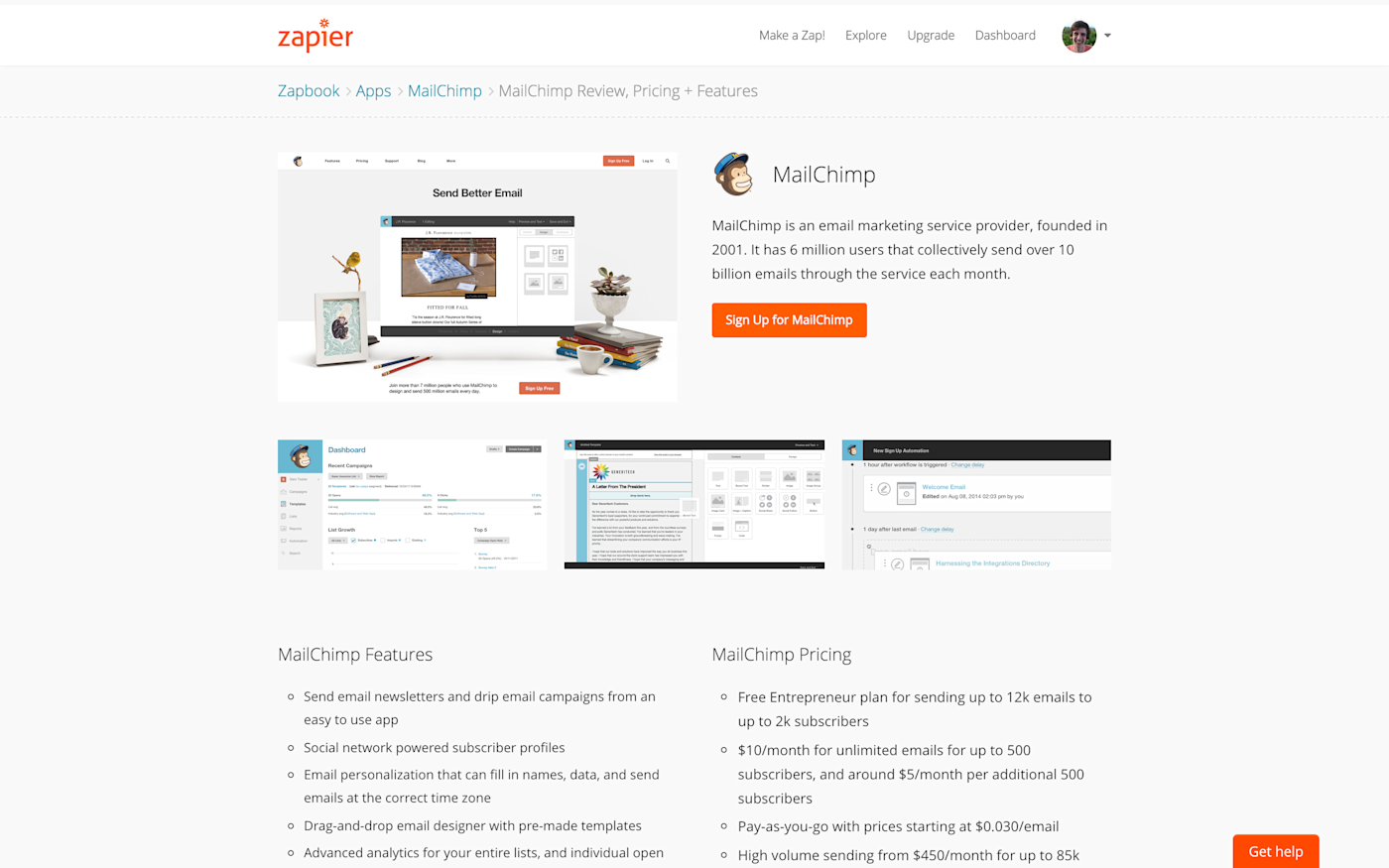
At Zapier, we’re focusing on three of the traction channels to measure the value we can get from them, see if they’re the best ones to put our time and money behind, and learn if we should be looking at other ones, as well.
Since you’re reading this, it may be obvious that one of those channels is content marketing. Our blog and are a source of traffic and new users as they're targeted at people who can get the most from Zapier—individuals working in small businesses, marketing departments or startups, and professionals who rely on a variety of web apps or aim to be more productive.
Another one is business development, as I mentioned before. We help promote our partner apps that are set up as integrations with Zapier, and in turn many of those partners help promote us since we can make parts of their service easier to use.
Finally, we’re focusing on email marketing. We encourage readers to sign up for the blog since we regularly create content that they might be interested in, and we let our users know if there are updates or improvements that might interest them. This also helps with promoting our webinars and other events.
Your Turn
If you enjoyed learning about the different traction channels and the bullseye framework, then the first thing you should do is go pick up a copy of Traction and get some more in-depth knowledge and examples.
After that, which traction channels are you focused on? Do you have any awesome examples of ways you leveraged one of the ones we talked about here? Let us know in the comments!
Credits: Customers photo courtesy Ryan McGuire. Trade show photo courtesy InsideView. Speaking engagement courtesy Web Summit.





